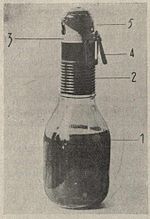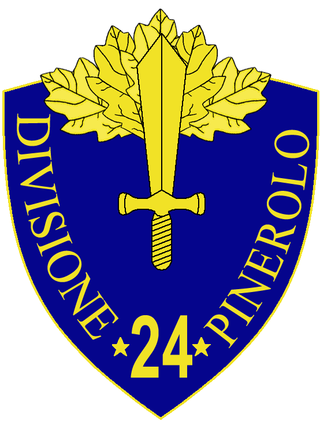
The 24th Infantry Division "Pinerolo" was an infantry division of the Royal Italian Army during World War II. The division was based in Chieti, with its regiments in the Abruzzo region. The division was named for the city of Pinerolo. The division's regimental depots were shared with the 62nd Infantry Division "Marmarica", which was based in Derna in Libya and recruited its men from and trained them in Abruzzo.

The 3rd Cavalry Division "Principe Amedeo Duca d'Aosta" was a Cavalry or "Celere" (Fast) division of the Royal Italian Army during World War II. The division was formed in 1934, and during World War II was mobilized in June 1940. As a cavalry division it took part in the Invasion of Yugoslavia and was part of the Italian Expeditionary Corps in Russia. Annihilated during the Red Army's Operation Little Saturn in December 1942, the survivors returned to Italy in spring 1943.

The 33rd Infantry Division "Acqui" was an infantry division of the Royal Italian Army during World War II. The Acqui was classified as a mountain infantry division, which meant that its artillery was moved by pack mules instead of the horse-drawn carriages of line infantry divisions. Italy's real mountain warfare divisions were the six alpine divisions manned by Alpini mountain troops. The division was named for the city of Acqui. The division is notable for having been massacred with remarkable cruelty after surrendering to the Germans on 21 September 1943. The main detachments of the Acqui division in the islands of Cephalonia and Corfu were officially dissolved 25 September 1943.

The 3rd Infantry Division "Ravenna" was an infantry division of the Royal Italian Army during World War II. The Ravenna was classified as a mountain infantry division, which meant that the division's artillery was moved by pack mules instead of the horse-drawn carriages of line infantry divisions. Italy's real mountain warfare divisions were the six alpine divisions manned by Alpini mountain troops. The Ravenna was named for the ancient city of Ravenna and based in the city of Alessandria. Its two infantry regiments were based in Alessandria (37th) and Alba (38th), respectively Alessandria and Tortona from 1939, with the division's artillery regiment also based in Alessandria.

The 37th Infantry Division "Modena" was a infantry division of the Royal Italian Army during World War II. The Modena was classified as a mountain infantry division, which meant that the division's artillery was moved by pack mules instead of the horse-drawn carriages of line infantry divisions. Italy's real mountain warfare divisions were the six alpine divisions manned by Alpini mountain troops. The division was formed on 25 March 1939 with units of the 5th Territorial Division "Imperia" and named for the city of Modena. The division was made up entirely of men from the city of Genoa and the surrounding Liguria region. The division's regimental depots were shared with the 63rd Infantry Division "Cirene", which was based in Benghazi in Libya and recruited its men from and trained them in Liguria.

The 44th Infantry Division "Cremona" was an infantry division of the Royal Italian Army during World War II. The Cremona was formed on 15 September 1939 by splitting the 20th Infantry Division "Curtatone and Montanara" into the 20th Infantry Division "Friuli" and 44th Infantry Division "Cremona". The division was named for the city of Cremona. The division served as occupation force on Corsica and fought German units after the Armistice of Cassibile was announced on 8 September 1943. The division then served with the Italian Co-belligerent Army and remained active until the 1975 Italian Army reform.

The 49th Infantry Division "Parma" was an infantry division of the Royal Italian Army during World War II. The Parma was activated on 12 September 1939 in Macerata and named for the city of Parma. After the announcement of the Armistice of Cassibile on 8 September 1943 the division was disbanded by German forces in Vlorë in Albania.

The 50th Infantry Division "Regina" was an infantry division of the Royal Italian Army during World War II. The Regina was formed on 1 March 1939 in the Italian Islands of the Aegean and entitled to the Queen. After the announcement of the Armistice of Cassibile between Italy and the Allies on 8 September 1943 the division fought Wehrmacht forces in the Battle of Rhodes. The majority of the division surrendered on 11 September 1943, while the III Battalion, 10th Infantry Regiment "Regina" resisted the Germans on Leros until 16 November 1943.

The 54th Infantry Division "Napoli" was an infantry division of the Royal Italian Army during World War II. The Napoli was formed on 15 April 1939 in Caltanissetta and named for the city of Naples. The division dissolved on 14 August 1943 in Melia southeast of Scilla in Calabria after being heavily decimated during the Allied invasion of Sicily. The division drafted men in southern Sicily and members of the division hailed from Caltanissetta, Agrigento, Syracuse and the surrounding territories.
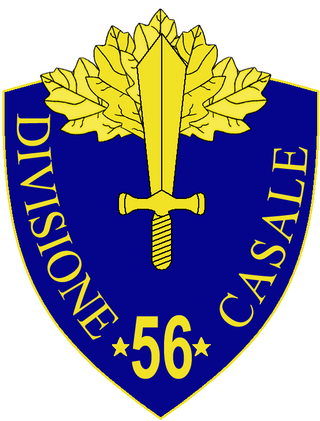
The 56th Infantry Division "Casale" was an infantry division of the Royal Italian Army during World War II. The Casale was activated on 15 June 1939 in Forlì and named for the city of Casale Monferrato and recruited most its men from the Romagna region. The division was sent to Greece as occupation and force. There the division was disbanded by invading German forces in the Aetolia-Acarnania region of Greece after the announcement of the Armistice of Cassibile on 8 September 1943.

The 57th Infantry Division "Lombardia" was an infantry division of the Royal Italian Army during World War II. The Lombardia was formed on 24 May 1939 in Pula and named for the region of Lombardy. The division was disbanded by the Germans after the Armistice of Cassibile was announced on 8 September 1943.

The 154th Infantry Division "Murge" was an infantry division of the Royal Italian Army during World War II. The Murge was formed on 1 December 1942 and named for the Murge plateau in Apulia. The Murge was classified as an occupation infantry division, which meant that the division's artillery regiment consisted of two artillery groups instead of the three artillery groups of line infantry divisions and that the divisional mortar battalion was replaced by a divisional machine gun battalion. The division was sent to Herzegovina as an occupation force, where it took part in anti-partisan operations. It took part in the Battle of the Sutjeska and then had to be withdrawn after suffering heavy losses. It was disbanded in September 1943, following the announcement of the Armistice of Cassibile.
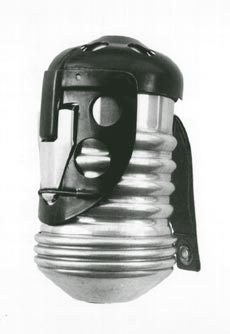
The Breda Mod. 35 is a hand grenade issued to the Royal Italian Army during World War II.

The Breda Mod. 42 was an anti-tank grenade, developed by Breda, supplied to the Royal Italian Army during World War II.

The OTO Mod. 35 was a hand grenade issued to the Regio Esercito during World War II.

The SRCM Mod. 35 is a hand grenade that was first issued to the Royal Italian Army in 1935, serving through World War II and into the 1980s. Nicknamed "Red Devils" by the British in 1941–1942 during the North African Campaign after the red color of the most common type.
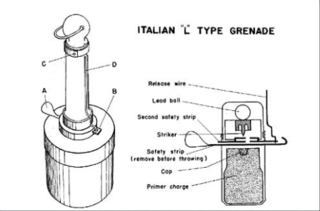
The Type L is an anti-tank hand grenade provided to the Royal Italian Army during World War II.

Passaglia Grenades, also known as P Bombs or Pazzaglia, are homemade weapons used by Italian soldiers during World War II, especially in the North African theater to overcome the chronic lack of effective weapons against armored enemies.
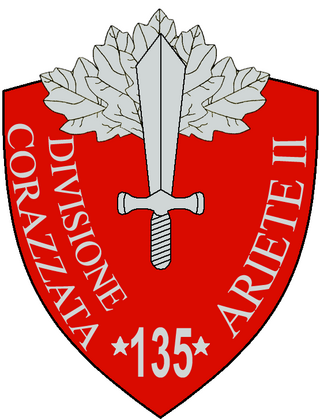
The 135th Armored Cavalry Division "Ariete" was an armored division of the Royal Italian Army during World War II. It was formed in 1943 and named to commemorate the 132nd Armored Division "Ariete", which had distinguished itself during the Western Desert campaign and was destroyed during the Second Battle of El Alamein. After the announcement of the Armistice of Cassibile on 8 September 1943 the division fought the invading German forces South of Rome. After two days the division was forced to surrender and was disbanded by the Germans on 12 September 1943.
This page is based on this
Wikipedia article Text is available under the
CC BY-SA 4.0 license; additional terms may apply.
Images, videos and audio are available under their respective licenses.
